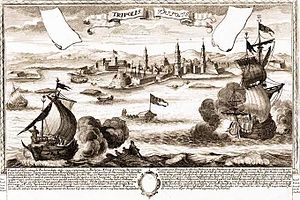Siege of Tripoli (1551)
| Siege of Tripoli | |||||||
|---|---|---|---|---|---|---|---|
| Part of the Ottoman-Habsburg wars and the Italian War of 1551–1559 and the Ottoman-Maltese wars | |||||||
 | |||||||
| |||||||
| Belligerents | |||||||
|
Order of Saint John |
| ||||||
| Commanders and leaders | |||||||
| Gaspard de Vallier |
Turgut Rais | ||||||
| Strength | |||||||
|
~30 ~630 mercenaries | ~10,000 | ||||||
| Casualties and losses | |||||||
| 630 enslaved | Unknown | ||||||
The siege of Tripoli occurred in 1551 when the Ottoman Turks and Barbary pirates besieged and vanquished the Knights of Malta in the Red Castle of Tripoli, modern Libya.[1] The Spanish had established an outpost in Tripoli in 1510, and Charles V remitted it to the Knights in 1530.[2][3] The siege culminated in a six-day bombardment and the surrender of the city on 15 August.
The siege of Tripoli was successive to an earlier attack on Malta in July, which was repelled, and the successful invasion of Gozo, in which 5,000 Christian captives were taken and brought on galleys to the location of Tripoli.
Siege
The city was under the command of Fra' Gaspard de Vallier, with thirty knights and 630 Italian and Sicilian mercenaries.[3] The Ottomans had a base since 1531 in the city of Tajura, 20 kilometers to the east, where Khayr al-Din had been based.[4] The Ottomans encircled the fort, and established 3 batteries of 12 guns each.[3]
The
Soon the soldiers in the fort mutinied, and negotiation for surrender started.
Aftermath

From Malta, d'Aramon wrote a letter about his intervention to

Upon his return to Malta,
The siege was the first step of the all-out
In 1553, Dragut was nominated commander of Tripoli by Suleiman, making the city an important center for piratical raids in the Mediterranean and the capital of the Ottoman province of Tripolitania.[4] In a famous attack from Tripoli, in 1558, Dragut attacked Reggio, and took all its inhabitants as slaves to Tripoli.[4][13]
In 1560, a powerful naval force was sent to recapture Tripoli, but that force was defeated in the Battle of Djerba.[14]
See also
- Red Castle of Tripoli
- List of Ottoman sieges and landings
- Franco-Ottoman alliance
- Timeline of Maltese history
- Battle of Tripoli (2011)
Notes
- ^ Cervantes in Algiers: a captive's tale by María Antonia Garcés p. 25 [1]
- ^ A history of Islamic societies Ira Marvin Lapidus p. 255 [2]
- ^ a b c d e f g The Mediterranean and the Mediterranean world in the age of Philip II by Fernand Braudel pp. 920– [3]
- ^ a b c d A history of the Maghrib in the Islamic period Jamil M. Abun-Nasr p. 190 [4]
- ^ ISBN 0-87169-161-2.
- ^ a b c The biographical dictionary of the Society for the diffusion of Knowledge p. 230 [5]
- ^ a b c A Universal Biography, John Platts p. 49: [6]
- ^ The Middle East and North Africa 2003, p. 748 [7]
- ^ History of the Ottoman Empire and modern Turkey by Ezel Kural Shaw p. 106 [8]
- ^ The Jew of Malta by Christopher Marlowe, N. W. Bawcutt p. 6
- ^ Achievements of the Knights of Malta Alexander Sutherland p. 108 [9]
- ^ Ancient and modern Malta by Pierre Marie Louis de Boisgelin de Kerdu p. 47
- ^ The History of England Sharon Turner, p. 311 [10]
- ^ A History of the Ottoman Empire to 1730: chapters from the Cambridge history by Vernon J. Parry p. 101 [11]
